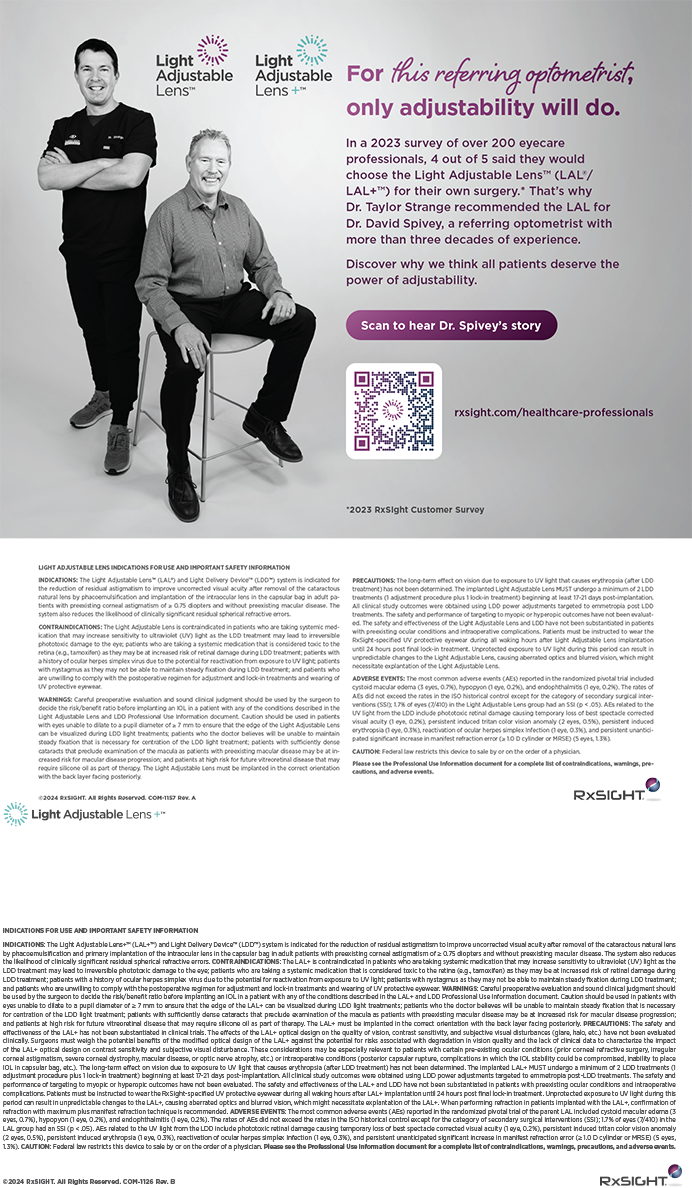
Reports of pain after ocular surgery are not uncommon, although it is rare for patients to experience serious consequences as a result. Any report of ocular pain or discomfort should be investigated as a potential harbinger of something serious, even though mild pain is to be expected after any surgery.
Surgery is the act of treating a condition or illness by means of an incisional procedure. Every eye surgery is controlled trauma to the eye—although, we hope, mild trauma—which inherently induces an inflammatory response. Fortunately for patients, modern techniques for ocular surgery, and for cataract surgery in particular, are intended to be minimally invasive and therefore less likely to induce a severe inflammatory response. Still, inflammation can cause pain, light sensitivity, redness, and other disconcerting symptoms.
Inflammation is likely the most common cause of postoperative pain, although it is only one potential trigger. Pain after ocular surgery can be caused by many factors, and most cases are easily treated.
This article discusses some of the common causes of pain during the postoperative period.
COMMON CAUSES OF POSTOPERATIVE PAIN
Dry eye disease (DED) or other ocular surface disease that was not adequately treated before surgery is a common cause of postoperative irritation. It should be noted that an irregular tear film, even in an eye treated for DED, can react unpredictably to surgery. Therefore, even treated patients with DED may be at greater risk for pain and discomfort after surgery. Thus, the potential for postoperative pain is another reason to carefully assess surgical candidates for ocular surface abnormalities during preoperative workup. Eyes with only mild DED or meibomian gland dysfunction are still at risk for postoperative issues.
Surgically induced inflammation is both an independent and an additive risk factor for postoperative pain. For example, inflammation can exacerbate DED and other ocular surface issues. In addition, the topical agents used to control inflammation postoperatively can sometimes worsen ocular surface issues, and patients may report this as pain, discomfort, or irritation. Finding the root cause of pain is paramount, and the perception of pain may be multifactorial in nature.
Systemic diseases can contribute to and worsen ocular inflammation, therefore inflammatory components should also be considered as sources of postoperative pain. Ocular conditions such as uveitis or iritis and systemic conditions such as a history of autoimmune disease (eg, rheumatoid arthritis, Crohn’s disease, ulcerative colitis, or scleritis) should be signals for extra vigilance.
Certain procedures performed during ocular surgery should also be considered as potential sources of irritation if a patient is complaining of postoperative pain. Limbal relaxing incisions or other refractive procedures such as LASIK and PRK may cause damage to the nerves of the cornea. If patients have had these procedures, it is worthwhile to check the integrity of the cornea to make sure there is not an epithelial defect causing the pain. Limbal relaxing incisions cut with a blade can develop filamentary keratitis or debris around the incision site. Although rare, abrasions can be caused by the docking mechanisms of some femtosecond laser platforms.
Another potential source of postoperative pain is increased IOP, which can be caused by a number of etiologies. Inflammation is one potential inciting mechanism for elevated IOP. Most cases of increased IOP on the day of surgery or postoperative day 1 are due to retained viscoelastic material. In these cases, patients typically need a topical antihypertensive agent to lower pressure, although in severel cases, an oral medication such as acetazolamide (Diamox; Teva) may be considered. A paracentesis may be necessary to manually “burp” the wound and release the viscoelastic.
In our practice, the surgeons take a little extra time during the irrigation/aspiration step performed in cataract patients with a known history of glaucoma to ensure that all of the viscoelastic material is removed from the eye.
POSTOPERATIVE PAIN MANAGEMENT
Topical drugs used postoperatively can be both a blessing and a curse with regard to pain. On the one hand, when applied properly, topical nonsteroidal anti-inflammatory drugs (NSAIDs), corticosteroids, and antibiotics help to control inflammation and infection, both of which are potential pain mechanisms. Getting patients to comply with drop regimens, however, is notoriously difficult. Even patients with the best of intentions may fail to properly instill drops. Patients, especially elderly cataract patients, may struggle to squeeze the medication bottle, the drops may miss the eye, and the act of squeezing the bottle may not produce an adequate dosage. Perhaps most confounding is that topical emulsions require patients to shake the bottle to properly mix the ingredients; failure to do so can result in inadequate drug delivery. The bottom line is that, although topical drugs are effective, poor compliance can leave patients at risk for postoperative inflammation and pain.
In our practice, we treat all patients preoperatively with an antibiotic to lower the potential for microbial growth postoperatively. Topical antibiotics and an NSAID are given for 2 days before surgery, and steroids are started the day of surgery. All three medications are then continued postoperatively.
Another agent used on the day of surgery also indirectly helps reduce postoperative pain. Cycloplegic agents have several effects: they relax the ciliary muscle’s spasm reflex, they help to prevent posterior synechiae, and they stabilize the blood aqueous barrier, all of which helps to reduce cell and flare in the anterior chamber. Thus, using a mydriatic agent during surgery can positively affect the potential for surgical inflammation and postoperative pain. Cycloplegics can also be used during the postoperative period to provide relief and decrease accommodation, which can trigger pain sensation.
There are differences between generic and branded formulations of postoperative topical medications that are important to consider in the context of postoperative pain. A few years ago in our clinic, we had many patients present as emergency walk-ins with red eyes postoperatively. After some investigation, we realized that a number of cases of rebound inflammation were taking place in patients using generic medications. We switched from prescribing a generic steroid to difluprednate ophthalmic emulsion 0.05% (Durezol; Alcon). We have not had this issue since. Presumably, that is because of better efficacy of the branded compared to the generic medication as well as a more consistent dose delivery. There is evidence in the literature for this; studies show that difluprednate is more efficacious than generic prednisolone acetate.1 In addition, the dose of prednisolone acetate that is instilled into the eye can change depending on how the bottle is stored or shaken before use.2
Often overlooked in the management of corneal abrasions after surgery is the beneficial role that a bandage contact lens can play. A bandage lens soaked in a topical NSAID can have a dual effect, assisting the healing process and also reducing inflammation and pain.
Another option that should not be forgotten is the use of over-the-counter pain relievers, such as acetaminophen. This is a reasonable option for patients with acute onset of pain in the first few postoperative days.
CONCLUSION
Modern ocular surgery—especially cataract surgery—is minimally invasive. There are steps eye care providers can take to further minimize the impact of surgically induced trauma. Preoperatively unmasking ocular surface conditions such as DED or meibomian gland dysfunction is paramount for decreasing discomfort and irritation after surgery. It is more important to closely follow patients with a known history of autoimmune or systemic factors that might increase the risk of inflammation and pain after surgery.
Patients’ reports of postoperative pain are highly subjective, but it is important for practitioners to try to understand the source of the problem as much as possible. The etiology of the pain will help guide the management strategy.
Often, pain occurring after surgery can be due to inflammation. In such cases, topical therapy directed at inflammation can be helpful, and the potential role of cycloplegic agents in palliative relief should not be overlooked.
1. Foster CS, Davanzo R, Flynn TE, et al. Durezol (difluprednate ophthalmic emulsion 0.05%) compared with Pred Forte 1% ophthalmic suspension in the treatment of endogenous anterior uveitis. J Ocul Pharmacol Ther. 2010 Oct;26(5):475-483.
2. Stringer W, Bryant R. Dose uniformity of topical corticosteroid preparations: difluprednate ophthalmic emulsion 0.05% versus branded and generic prednisolone acetate ophthalmic suspension 1%. Clin Ophthalmol. 2010;4:1119-1124.
Josh Johnston, OD, FAAO
• clinical director, residency director, Georgia Eye Partners, Atlanta
• drj@gaeyepartners.com
• financial disclosure: consultant to Alcon, Allergan, Bio-Tissue, and Shire


